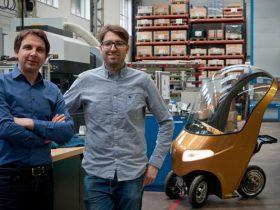While Back to the Future’s vision of a world with hoverboards and flying cars has yet to come true, transport is changing, and Intelligent Transport Systems are the driving force behind these developments. A new research partnership between the University of the Sunshine Coast (USC) and the Queensland Government will help prepare the state for futuristic transport that uses emerging technologies to better connect people and goods in more sustainable, efficient and convenient ways.
USC Senior Lecturer in Environmental Engineering, Dr Helen Fairweather, said the three-year Transport Academic Partnership, including the Department of Transport and Main Roads’ funding support, was not only exciting for the university’s students and academics, but would also have a profound impact on the wider community and environment.
“Transport is changing rapidly, and we need more research that targets the interface between civil infrastructure and the Internet of Things (IoT),” Dr Fairweather said.
“The key questions are: How do we move people and goods without relying on systems for fuel-emitting cars, and how can technology help us achieve that?
“It’s not just about electric cars and light rail. It’s about how telecommunications and advanced analytics can change how our transport network operates and how more sustainable service can be provided.”
Dr Fairweather said that the specific research projects will be jointly developed with the Department of Transport and Main Roads once a foundation USC Chair of Sustainable Transport Engineering has been appointed at its Moreton Bay campus.
However, initial areas of focus would include the use of big data analytics and Artificial Intelligence (AI) in smart transport.
The Moreton Bay campus will become a field site for testing cutting-edge transport innovations, such as:
♦ New IoT sensor technologies for Intelligent Transport Systems
♦ Advanced video imagery for providing information about vehicle movements and assessing areas of traffic congestion
♦ Access to vehicle-based data to analyse driver and passenger behaviour
♦ Advanced AI to understand differences amongst distinct road user groups in typical traffic situations Dr Fairweather said that Intelligent Transport Systems have delivered important but incremental changes to Australia’s transport systems, and the momentum to advance Australia’s transport technology industries is only growing.
“We are already seeing major changes in terms of the way traffic moves in the cities, e.g. using sensors, CCTV footage and AI to better control traffic lights and variable speed signs to improve traffic flow.
This is providing a 20-30 per cent uplift in capacity for the same infrastructure, supporting more sustainable outcomes,” Dr Fairweather said.
“Electric and hydrogen-powered vehicles will be the single biggest transformation over the coming decade as the technology is proven now, and scale and affordability will come as the volume of sales increase.
“Full situational awareness of the transport network will become more customer focused, enabling customers to make more informed choices around whether to travel, what mode of transport to use, when to travel and what on-trip changes are necessary to optimise their journey.
“There are some innovations in terms of maintenance using video captured by vehicles and AI to improve the response to road maintenance needs.
Flooding alerts in regional areas are becoming more sophisticated which is critical for road users, particularly in preventing motorists from entering flooded roads.”
Predictions for future transport technology innovations
According to Dr Fairweather, futuristic transport technologies are not far on the horizon as we start to see vehicles with connected and autonomous technologies emerging over the next couple of decades.
“Connectivity of vehicles to roadside infrastructure and the ability for vehicles to exchange information and data (talk to each other) is already emerging in Europe, USA and Asia.
These technologies will be critical in improving safety and will be important in the roadmap to full automation,” Dr Fairweather said.
“Depending on how this is rolled out between industry suppliers, government regulators and road authorities, this is likely to blur the current distinction between private vehicle ownership and public transport.
“The Mobility as a Service (MAAS) model, where people subscribe to a suite of transport options and pay a monthly fee as opposed to having to own anything, could therefore become a viable service offering.
This subscription package would include access to everything – public transport, e-transport (e.g.. electric scooters), cars, buses, trains etc.
“I do see a time when we will be able to use personal mobility options for first and last mile transport between major bus and rail networks, though active transport (e.g. cycling and walking) provides a better option in terms of public health outcomes.”
Dr Fairweather said one potential technology of the future could consist of multi-purpose on-demand freight/passenger options with ‘capsules’ linked to a trackless tram-type system.
Each business might be able to call for a ‘freight capsule’ to go past their door, or use drones to transport lighter freight to the nearest capsule.
Perhaps the capsule can be configured quickly to change from a transport to a freight option to optimise its use. “Overall, autonomous public transport options will be cheaper to run and will become more accessible to regional communities, lessening their reliance on private vehicles, while big data analytics and AI will provide for more optimum traffic networks in the future,” Dr Fairweather said.
“In terms of sustainability, I think there will be a greater focus on the fuels and construction materials we’re using, Building Information Modelling (BIM) to conceive, design, build and manage transport infrastructure, transition to more active transport and better understanding of the socio-economic aspects of equity when it comes to access to public transport options.”
Collaboration key to improving Australia’stransport networks
Transport and Main Roads Minister, Mark Bailey, said the Queensland Government welcomed the opportunity to work with USC and look ahead at new, innovative ideas that would enable all Australians to move more safely, efficiently, and sustainably through the nation’s transport networks.
“This partnership will enable USC to research and provide insights into the type of technologies we will use to move from A to B in the next few decades,” Mr Bailey said.
“Queensland is well placed to be at the forefront of transport innovation. I look forward to the team’s work exploring how future technology can boost our capability to deliver a single, integrated transport network accessible to everyone.”
Dr Fairweather agreed that Queensland is well placed to be at the forefront of transport innovation compared to other states because the Department of Transport and Main Roads understands the importance of partnering with academia to accelerate the development and deployment of technologies that will shape the future of transport.
“The department has positioned itself to undertake and make use of the latest cutting-edge research in the transport field through their investment in a Transport Academic Partnerships across Brisbane Partner Universities, with the intent to extend that to other regional universities,” Dr Fairweather said.
“They are very mindful that the skills required of their workforce is rapidly changing and the university partnerships will be critical to providing the courses for this upskilling.
“They also make an active investment in applied research programs so they can continue to improve, adapt and adopt new ways of doing things.”
As part of a Transport Academic Partnership, Department of Transport and Main Roads will provide advice on their research needs to ensure the research projects align with their strategic plan and the Queensland Government priorities of supporting economic activity and job creation, improving community safety and protecting the environment.
“Through this research partnership, civil infrastructure and IoT will become better integrated by developing and deploying the appropriate and fit-for-use technology and communication protocols to protect individual privacy and maximise cyber security, while providing the analytics to make a major shift in the development and operation of our transport infrastructure,” Dr Fairweather said.
Link: https://infrastructuremagazine.com.au/2021/08/25/shared-smart-and-sustainable-the-transport-network-of-the-future/?utm_source=pocket_mylist
Source: https://infrastructuremagazine.com.au

















Leave a Reply